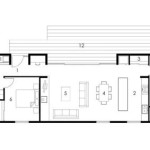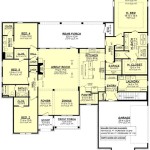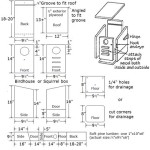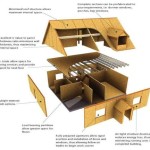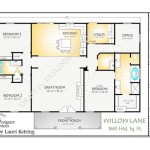Designing your own house floor plans refers to the process of creating a blueprint for your future home, taking into account your specific needs, preferences, and lifestyle. Unlike traditional methods where you rely on pre-made designs or work with an architect, designing your own floor plans empowers you with the freedom to customize every aspect of your living space.
Whether you’re a seasoned homeowner or embarking on your first homeownership journey, designing your own floor plans can be an exciting and rewarding experience. It allows you to visualize your dream home, make informed decisions about its layout and functionality, and ultimately create a space that truly reflects your individuality.
In the following sections, we will guide you through the various aspects involved in designing your own house floor plans, from planning and budgeting to choosing materials and incorporating sustainable features. We will also provide valuable tips and resources to help you navigate this process seamlessly and create a home that meets your every need.
Designing your own house floor plans is a multi-faceted process that encompasses various important considerations. Here are ten key points to keep in mind:
- Define your needs and lifestyle
- Set a realistic budget
- Choose a suitable lot
- Consider energy efficiency
- Plan for smart home features
- Maximize natural light
- Prioritize flow and functionality
- Incorporate outdoor living spaces
- Allow for future expansion
- Seek professional advice when needed
By carefully considering these points, you can create a house floor plan that not only meets your current needs but also provides a comfortable and enjoyable living space for years to come.
Define your needs and lifestyle
The first and most important step in designing your own house floor plans is to define your needs and lifestyle. This involves carefully considering how you and your family live, what activities you enjoy, and what features are essential to your daily routines.
- Number of bedrooms and bathrooms: Determine how many bedrooms and bathrooms you need based on your current and future family size. Consider the need for guest rooms or additional bathrooms for convenience.
- Living spaces: Think about how you use your living spaces. Do you need a formal living room, a cozy family room, or both? Consider the size and layout of these spaces to accommodate your furniture and activities.
- Kitchen and dining areas: Plan the kitchen and dining areas to suit your cooking and eating habits. Consider the amount of counter space, storage, and appliances you need. Decide whether you want a separate dining room or a more open concept kitchen-dining area.
- Outdoor spaces: If you enjoy spending time outdoors, consider incorporating outdoor living spaces into your plans. This could include a patio, deck, or porch, as well as features like a fire pit or outdoor kitchen.
By taking the time to define your needs and lifestyle, you can create a house floor plan that is tailored to your specific requirements and provides a comfortable and enjoyable living space for you and your family.
Set a realistic budget
Once you have defined your needs and lifestyle, the next step is to set a realistic budget for your house floor plans. This involves carefully considering all the costs associated with designing and building your home, including:
- Land acquisition: The cost of the land you choose will vary depending on its location, size, and topography.
- Design fees: If you hire an architect or designer to create your floor plans, their fees will need to be factored into your budget.
- Building materials: The cost of building materials will vary depending on the type of materials you choose and the size of your home.
- Labor costs: The cost of labor will vary depending on the complexity of your design and the location of your build.
- Permits and inspections: You will need to obtain permits and inspections throughout the building process, which will also add to the cost.
It is important to be realistic about your budget and to factor in all of the potential costs involved. This will help you avoid overspending and ensure that your project stays on track.
Here are some tips for setting a realistic budget:
- Research and compare costs: Get quotes from different contractors and suppliers to compare costs and find the best deals.
- Prioritize your needs: Decide which features are most important to you and allocate your budget accordingly.
- Be flexible: Be prepared to make adjustments to your plans or materials if necessary to stay within your budget.
- Consider long-term costs: In addition to the upfront costs of building your home, consider the ongoing costs of maintenance, repairs, and utilities.
By following these tips, you can set a realistic budget for your house floor plans and ensure that your dream home becomes a reality.
Choose a suitable lot
Choosing a suitable lot is a crucial step in the process of designing your own house floor plans. The lot you choose will determine the size, shape, and orientation of your home, as well as its access to sunlight, views, and other amenities. Here are some key factors to consider when choosing a lot:
Size and shape
The size and shape of the lot will determine the size and shape of your home. It is important to choose a lot that is large enough to accommodate your desired home size, as well as any outdoor living spaces you may want, such as a patio, deck, or pool. The shape of the lot will also affect the layout of your home. For example, a long, narrow lot may be better suited for a linear floor plan, while a wide, square lot may be better suited for a more open floor plan.
Orientation
The orientation of the lot will determine how your home is positioned in relation to the sun. This is an important consideration for energy efficiency, as well as for natural lighting and views. Ideally, you want to choose a lot that is oriented so that the main living areas of your home face south, to take advantage of the sun’s warmth and natural light. However, you may also want to consider the views from the lot, as well as the prevailing wind direction, when choosing its orientation.
Access and utilities
It is also important to consider access to the lot and the availability of utilities when choosing a lot. You will need to make sure that there is adequate access to the lot for construction vehicles and materials. You will also need to make sure that the lot has access to water, sewer, electricity, and gas, if necessary. If the lot does not have access to these utilities, you may need to factor in the cost of installing them.
Zoning and restrictions
Finally, you need to make sure that the lot you choose is zoned for residential use and that there are no restrictions on building on the lot. You can check with the local zoning board to find out what the zoning regulations are for the lot and to determine if there are any restrictions on building size, height, or setbacks.
By carefully considering all of these factors, you can choose a suitable lot for your new home that will meet your needs and lifestyle.
Consider energy efficiency
When designing your own house floor plans, it is important to consider energy efficiency. This will help you save money on your energy bills and reduce your environmental impact. Here are a few things to keep in mind:
Insulation
Insulation is one of the most important factors in energy efficiency. It helps to keep your home warm in the winter and cool in the summer, reducing the amount of energy you need to heat and cool your home. Be sure to insulate your walls, roof, and floors to the recommended levels for your climate zone.
Windows and doors
Windows and doors are another important factor in energy efficiency. Choose windows and doors that are ENERGY STAR certified. ENERGY STAR certified windows and doors meet strict energy efficiency standards, which means they will help you save energy and money. Be sure to install your windows and doors properly to avoid air leaks.
Appliances
When choosing appliances, look for ENERGY STAR certified models. ENERGY STAR certified appliances meet strict energy efficiency standards, which means they will use less energy than non-certified models. ENERGY STAR certified appliances can save you money on your energy bills and help you reduce your environmental impact.
Lighting
Lighting is another area where you can save energy. Choose energy-efficient light bulbs, such as LED or CFL bulbs. LED and CFL bulbs use less energy than traditional incandescent bulbs, and they last longer. You can also save energy by using natural light whenever possible. Open your curtains or blinds during the day to let in the sunlight, and turn off lights when you leave a room.
Landscaping
Landscaping can also help you save energy. Plant trees around your home to shade your home from the sun in the summer. In the winter, deciduous trees will lose their leaves, allowing the sun to shine in and warm your home. You can also plant shrubs and other vegetation around your home to help block the wind.
Other considerations
In addition to the above, there are a few other things you can do to improve the energy efficiency of your home:
- Use a programmable thermostat to automatically adjust the temperature of your home when you are away or asleep.
- Install a tankless water heater to provide hot water on demand, rather than storing hot water in a tank.
- Consider installing solar panels to generate your own electricity.
By following these tips, you can design an energy-efficient home that will save you money on your energy bills and reduce your environmental impact.
In addition to the above, you may also want to consider hiring a qualified energy auditor to assess your home’s energy efficiency and make recommendations for improvements. An energy auditor can help you identify areas where you can save energy and money.
Plan for smart home features
Smart home features can make your life more convenient, comfortable, and secure. When designing your own house floor plans, take some time to consider which smart home features you would like to incorporate into your home.
- Smart lighting: Smart lighting allows you to control your lights from anywhere using a smartphone app or voice commands. You can set schedules, create scenes, and adjust the brightness and color of your lights. Smart lighting can also be integrated with other smart home devices, such as motion sensors and security cameras.
- Smart thermostats: Smart thermostats allow you to control the temperature of your home from anywhere using a smartphone app or voice commands. You can set schedules, create scenes, and adjust the temperature of your home remotely. Smart thermostats can also be integrated with other smart home devices, such as motion sensors and occupancy sensors, to save energy.
- Smart security systems: Smart security systems allow you to monitor and control your home’s security from anywhere using a smartphone app or voice commands. You can receive alerts if there is a break-in, view live video footage of your home, and control your door locks and other security devices remotely. Smart security systems can also be integrated with other smart home devices, such as motion sensors and smart lighting, to create a comprehensive security system.
- Smart home hubs: Smart home hubs allow you to connect and control all of your smart home devices from one central location. You can use a smartphone app or voice commands to control your lights, thermostats, security system, and other smart home devices. Smart home hubs can also be used to create scenes and automations, which allow you to control multiple devices with a single command.
These are just a few of the many smart home features that you can incorporate into your home. By carefully planning for smart home features, you can create a home that is more convenient, comfortable, and secure.
Maximize natural light
Natural light can make your home feel more spacious, inviting, and uplifting. It can also help to reduce your energy costs by reducing the need for artificial lighting. When designing your own house floor plans, there are a few things you can do to maximize natural light:
Orient your home to the sun
The orientation of your home will have a big impact on how much natural light you get. Ideally, you want to orient your home so that the main living areas face south, to take advantage of the sun’s warmth and natural light. However, you may also want to consider the views from the lot, as well as the prevailing wind direction, when choosing its orientation.
Use large windows and doors
Large windows and doors will allow more natural light to enter your home. When choosing windows and doors, look for models that are ENERGY STAR certified. ENERGY STAR certified windows and doors meet strict energy efficiency standards, which means they will help you save energy and money. Be sure to install your windows and doors properly to avoid air leaks.
Use skylights
Skylights are a great way to add natural light to interior spaces, such as hallways, bathrooms, and closets. Skylights can be installed in any room of your home, but they are most effective in rooms with high ceilings.
Use light-colored finishes
Light-colored finishes, such as white, cream, and light gray, will reflect more light than dark-colored finishes. This can help to make your home feel more spacious and bright. You can use light-colored finishes on your walls, ceilings, and floors to maximize natural light.
Paragraph after details
By following these tips, you can maximize natural light in your home and create a more inviting and uplifting living space.
Prioritize flow and functionality
The flow and functionality of your home are essential to creating a comfortable and livable space. When designing your own house floor plans, it is important to consider how you will use each space and how the spaces will connect to each other.
- Create a clear circulation pattern: The circulation pattern of your home refers to the way people move through the space. You want to create a clear and efficient circulation pattern that allows people to move easily from one space to another. Avoid creating dead-end spaces or bottlenecks.
- Define each space clearly: Each space in your home should have a clear purpose and function. Avoid creating spaces that are too large or too small for their intended use. Make sure that each space has enough furniture and storage to meet your needs.
- Consider the adjacencies of spaces: The adjacencies of spaces refers to how the spaces are connected to each other. You want to group spaces that are related to each other together. For example, the kitchen, dining room, and living room should be located near each other. The bedrooms and bathrooms should be located in a separate area of the house.
- Provide adequate storage space: Storage space is essential for keeping your home organized and clutter-free. Make sure to include enough storage space in each room of your home. You can use a variety of storage solutions, such as closets, cabinets, drawers, and shelves.
By following these tips, you can create a home that is both beautiful and functional.
Incorporate outdoor living spaces
Outdoor living spaces are a great way to extend your living space and enjoy the outdoors. When designing your own house floor plans, consider incorporating one or more outdoor living spaces into your design. Here are a few things to keep in mind:
Location
The location of your outdoor living space is important. You want to choose a location that is private, protected from the elements, and has easy access from your home. If you have a pool or other water feature, you will also need to consider the safety of children and pets.
Size and shape
The size and shape of your outdoor living space will depend on your needs and the size of your property. If you have a large property, you may want to consider a large outdoor living space with multiple seating areas, a dining area, and a kitchen. If you have a smaller property, you may want to consider a smaller outdoor living space with a more intimate setting.
Amenities
The amenities you include in your outdoor living space will depend on your needs and interests. Some popular amenities include a patio or deck, a fire pit, a grill, and outdoor furniture. You may also want to consider adding a water feature, such as a pool, hot tub, or fountain.
Privacy
Privacy is an important consideration for any outdoor living space. You want to create a space that is private and secluded, so that you can relax and enjoy the outdoors without being disturbed. You can use a variety of methods to create privacy, such as planting trees and shrubs, building a fence or wall, or using privacy screens.
By following these tips, you can incorporate an outdoor living space into your home design that is both beautiful and functional.
Allow for future expansion
When designing your own house floor plans, it is important to consider future expansion. This means designing your home in a way that allows you to easily add on additional space in the future, if needed. There are a few things you can do to allow for future expansion:
- Design a flexible floor plan: A flexible floor plan is one that can be easily adapted to change. For example, you may want to design your home with an open floor plan, which can be easily reconfigured to add on additional space. You may also want to consider designing your home with a modular design, which allows you to add on additional modules as needed.
- Leave room for expansion: When designing your home, be sure to leave room for future expansion. This means leaving enough space on your lot for an addition, and designing your home in a way that allows for an addition to be easily added on. For example, you may want to design your home with a foundation that is large enough to support an addition, and you may want to design your roof in a way that allows for an addition to be added on without having to tear off the existing roof.
- Consider your future needs: When designing your home, consider your future needs. For example, if you are planning to have children in the future, you may want to design your home with an extra bedroom or two. If you are planning to retire in your home, you may want to design your home with a first-floor master suite.
- Work with an architect: If you are not sure how to design your home for future expansion, you may want to work with an architect. An architect can help you create a floor plan that meets your current and future needs.
By following these tips, you can design a home that is both beautiful and functional, and that can easily be expanded in the future to meet your changing needs.
Seek professional advice when needed
There are many aspects to consider when designing your own house floor plans. If you are not sure how to proceed or if you have a complex design in mind, it is advisable to seek professional advice from an architect or designer.
- Expertise and experience: Architects and designers have the expertise and experience to help you create a floor plan that meets your specific needs and requirements. They can also help you avoid common pitfalls and ensure that your home is built to code.
- Objectivity: A professional can provide an objective perspective on your design. They can help you identify areas where your plan could be improved, and they can offer suggestions that you may not have considered on your own.
- Time savings: Hiring a professional can save you time and hassle. They can take care of the technical aspects of design, so you can focus on the other aspects of building your home.
- Peace of mind: Knowing that your home was designed by a professional can give you peace of mind. You can rest assured that your home is safe, functional, and beautiful.
If you are considering designing your own house floor plans, it is important to weigh the benefits and drawbacks of seeking professional advice. If you have the time, skills, and confidence to design your own home, then you may be able to save money by doing so. However, if you are not sure how to proceed or if you have a complex design in mind, it is advisable to seek professional help.










Related Posts


